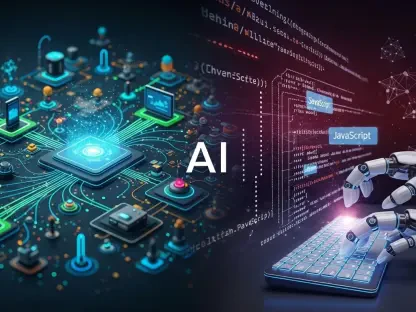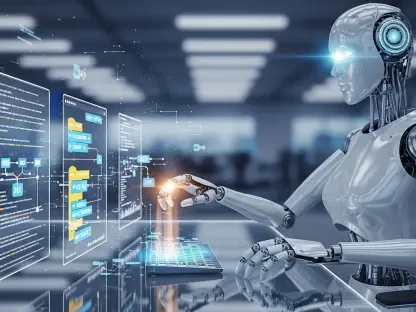The Current Landscape of Software Development in 2025
The software development industry stands at a transformative juncture, with artificial intelligence (AI) emerging as a powerful force reshaping workflows and expectations across the globe. A comprehensive survey capturing responses from 24,534 developers across 194 countries reveals the sheer scale and diversity of this ecosystem, highlighting the profound influence of technological advancements. This global snapshot positions AI as a central driver of change in how developers approach their craft. The data not only showcases the widespread integration of cutting-edge tools but also reflects the evolving dynamics of a profession that spans countless regions and skill levels.
Key segments of the ecosystem, such as programming languages, development tools, and integrated development environments (IDEs), reflect distinct trends and regional variations. Languages like TypeScript, Rust, and Go are gaining traction, while older ones like PHP see declining usage, signaling a shift toward modern, efficient solutions. Meanwhile, AI integration is becoming a dominant force, influencing everything from code generation to project management. Tool providers and IDE developers are racing to embed AI capabilities, with market leaders adapting rapidly to meet the growing demand for smarter, more intuitive systems that streamline complex tasks.
Prominent players in the market, including major tech firms and specialized software vendors, are shaping this landscape by prioritizing AI-driven solutions. Their innovations are redefining developer workflows, enabling faster delivery and enhanced collaboration. As AI tools become more embedded in daily operations, their role in addressing regional disparities and catering to diverse needs grows, setting the stage for a more connected yet competitive industry. This convergence of technology and market forces illustrates the profound transformation underway in software development.
AI Adoption and Its Impact on Developers
Trends in AI Tool Usage
The adoption of AI tools has reached remarkable levels, with 85% of developers incorporating them into their coding practices. A significant 62% rely on AI coding assistants to handle routine tasks, reflecting a growing trust in these technologies. This widespread usage spans various functions, from generating boilerplate code to drafting documentation, showcasing how AI is becoming an indispensable part of the development process across skill levels and project types.
Despite this reliance, developers maintain a clear boundary on AI’s role, reserving critical tasks like debugging and application design for human oversight. This balance highlights a preference for leveraging AI for repetitive work while preserving creative and strategic control. Such delegation not only optimizes time but also allows professionals to focus on high-value contributions that require nuanced judgment and expertise.
Looking ahead, 68% of developers anticipate that proficiency in AI tools will soon be a mandatory skill in the industry. This perception underscores a shift in professional expectations, where mastering AI is seen as essential as traditional coding abilities. As this mindset takes hold, the ability to effectively use AI is poised to become a benchmark for career advancement and relevance in an increasingly automated field.
Efficiency Gains and Market Insights
The impact of AI on productivity is undeniable, with nine out of ten developers reporting time savings of at least an hour per week. Notably, 20% save the equivalent of a full workday, illustrating the transformative potential of these tools. Such efficiency gains are reshaping how projects are scoped and delivered, allowing teams to tackle more ambitious goals within tighter timelines.
These improvements are also influencing market dynamics, as employers begin to recalibrate productivity expectations. The ability to accomplish more in less time is raising the bar for performance, with companies increasingly seeking candidates who can maximize AI’s benefits. This trend is creating a competitive job market where adaptability to AI-driven workflows becomes a key differentiator for hiring and retention.
As this evolution continues, the demand for developers skilled in leveraging AI is expected to intensify. Organizations are likely to prioritize talent capable of integrating these tools seamlessly, pushing the industry toward a future where efficiency and innovation are intertwined. This shift signals a broader transformation in how value is measured, with speed and precision becoming critical metrics of success.
Challenges and Concerns with AI Integration
While AI adoption is widespread, a notable 15% of developers remain hesitant to embrace these tools. Their reluctance often stems from skepticism about reliability, concerns over data security, or a preference for traditional methods. This resistance points to a diversity of perspectives within the industry, where not all professionals are ready to cede control to automated systems.
Even among users, significant challenges persist, with inconsistent code quality topping the list of grievances. Privacy risks, potential skill degradation, and AI’s lack of context awareness in complex scenarios further compound these issues. Such concerns highlight the need for ongoing refinement of AI technologies to ensure they align with the nuanced demands of real-world development.
Addressing these hurdles requires a multifaceted approach, including enhanced AI training to improve output accuracy and robust security protocols to safeguard sensitive data. Encouraging balanced human-AI collaboration can also mitigate skill erosion by ensuring developers remain engaged in critical thinking. These strategies, if implemented effectively, could bridge the gap between AI’s promise and its current limitations, fostering greater trust and adoption.
Regulatory and Ethical Considerations in AI-Driven Development
The integration of AI in software development is not without regulatory scrutiny, as data privacy laws and security standards gain prominence. Governments and industry bodies are increasingly focused on ensuring that AI tools comply with stringent guidelines to protect user information and maintain system integrity. This evolving landscape demands that developers and organizations stay abreast of legal requirements to avoid potential pitfalls.
Ethical implications also loom large, particularly when AI-generated code is used in critical applications like healthcare or infrastructure. Questions of accountability and transparency arise, as stakeholders grapple with who bears responsibility for errors or biases in automated outputs. These concerns necessitate a framework that prioritizes ethical considerations alongside technological advancement, ensuring public trust in AI-driven solutions.
As regulations tighten, industry practices may shift toward mandatory disclosure of AI tool usage and stricter accountability measures. Such changes could redefine how projects are documented and audited, placing additional compliance burdens on development teams. Navigating this complex terrain will require proactive engagement from all parties to balance innovation with responsibility, shaping a sustainable path for AI’s role in the sector.
Future Directions of AI in the Developer Ecosystem
Emerging AI technologies, such as advanced context-aware models, promise to address current shortcomings by delivering more relevant and accurate assistance. AI-enhanced debugging tools are also on the horizon, potentially revolutionizing how developers identify and resolve issues. These innovations could elevate the precision of automated systems, making them indispensable partners in tackling intricate challenges.
Market disruptors, including fully automated coding platforms, are poised to challenge traditional developer roles by handling entire projects with minimal human input. While still in early stages, such platforms could redefine job scopes, shifting focus from coding to oversight and strategy. This potential upheaval signals a need for professionals to adapt by acquiring skills that complement rather than compete with automation.
Global economic conditions, rapid AI innovation, and consumer demand for accelerated software delivery will further shape growth areas. From 2025 to 2027, these factors are expected to drive investment in scalable AI solutions that cater to diverse industries. As pressure mounts for faster, more efficient development cycles, the ecosystem will likely see intensified collaboration between humans and machines, paving the way for unprecedented advancements.
Conclusion: Navigating the AI-Driven Future of Development
Reflecting on the insights gathered, it is evident that AI has carved a transformative path within the developer ecosystem, delivering remarkable efficiency while presenting persistent challenges. The balance between time savings and concerns like code quality or privacy has defined much of the discourse, shaping how professionals approach their roles. This duality underscores the need for careful integration of technology into established practices.
Moving forward, developers are encouraged to upskill in AI tools to stay competitive, focusing on mastery of context-aware systems and security protocols. Employers, on the other hand, must establish balanced productivity metrics that value both human creativity and automated output, ensuring fair assessment of contributions. Policymakers face the task of crafting regulations that address privacy and accountability without stifling innovation, fostering an environment of trust.
The journey ahead promises growth through AI-driven collaboration, with potential breakthroughs in automation and cross-industry applications. Stakeholders who embrace adaptability and proactive learning stand to gain the most, navigating uncharted territories with resilience. This era of change, though complex, holds the seeds of opportunity for those ready to cultivate them.









